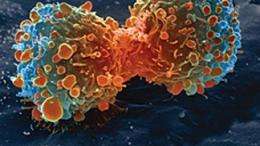Cancer: Unraveling a mechanism behind cellular proliferation

A hallmark of cancer is uncontrolled and sustained cell division. One particular overactive protein is implicated in this malfunction. EPFL scientists have discovered a complex mechanism that regulates this protein's activity in healthy cells.
Oncologists have STAT3 in their sights. This protein, which plays a role in cell division, is at the heart of a complex series of reactions within the cell. In many cancers, it is overactive – this generally is a negative element in terms of survival, because cells have a marked tendency to proliferate. EPFL scientists have unraveled the chain of events that trigger or inhibit the activity of the protein in healthy cells. Their discovery, published in the journal Molecular Cell, could lead to the identification of new therapeutic targets.
The process begins when a growth factor binds to receptors located on the cell membrane. This event triggers the cell to produce the protein STAT2. Curiously, the cell also simultaneously produces an inhibitor, called PIAS, that deactivates the protein, rendering STAT3 completely dormant.
When the inhibitor is inhibited, STAT3 gets going
How is STAT3 activated? The researchers discovered that in certain circumstances a cell regulator, the "endoplasmic reticulum," releases an inhibitor – to the inhibitor! When the first inhibitor is inhibited, STAT3 is let loose, which will favor cell division.
"It's only favorable for the cell to divide when all is well," explains EPFL professor Gisou Van der Goot, primary author of the study. "We found that if a cell is stressed, the endoplasmic reticulum doesn't release the inhibitor." In order to neutralize STAT3 in cancer cells, then, the release of this second inhibitor needs to be prevented.
STAT3 has been the focus of considerable interest by researchers for several years. They know that when the protein is overactive, cancer tends to produce metastases more easily. By recreating the chain of events that produces and regulates the protein, the researchers hope that it will be possible to identify and develop new strategies in the fight against cancer.
More information: Asvin K.K. Lakkaraju, F. Gisou van der Goot, Calnexin Controls the STAT3-Mediated Transcriptional Response to EGF, Molecular Cell Volume 51, Issue 3, 386-396, 8 August 2013. www.cell.com/molecular-cell/ab … 1097-2765(13)00508-X















